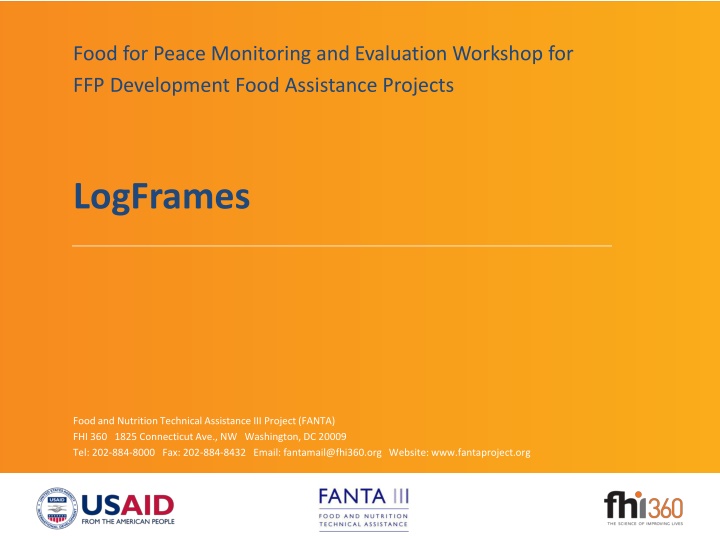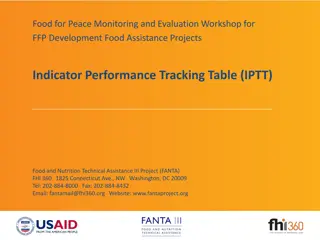
Food for Peace Monitoring and Evaluation Workshop LogFrames Summary
Explore the comprehensive approach of logframes in facilitating project design, monitoring, and evaluation within food assistance initiatives. Understand how logframes communicate project objectives and support M&E plans effectively.
Download Presentation

Please find below an Image/Link to download the presentation.
The content on the website is provided AS IS for your information and personal use only. It may not be sold, licensed, or shared on other websites without obtaining consent from the author. If you encounter any issues during the download, it is possible that the publisher has removed the file from their server.
You are allowed to download the files provided on this website for personal or commercial use, subject to the condition that they are used lawfully. All files are the property of their respective owners.
The content on the website is provided AS IS for your information and personal use only. It may not be sold, licensed, or shared on other websites without obtaining consent from the author.
E N D
Presentation Transcript
Food for Peace Monitoring and Evaluation Workshop for FFP Development Food Assistance Projects LogFrames Food and Nutrition Technical Assistance III Project (FANTA) FHI 360 1825 Connecticut Ave., NW Washington, DC 20009 Tel: 202-884-8000 Fax: 202-884-8432 Email: fantamail@fhi360.org Website: www.fantaproject.org
Session Objectives By the end of this session, participants will have: Explained what their project s LogFrame communicates and how it supports their particular project s M&E plan and system Defined the key components of a LogFrame and how each component relates to each other LogFrames
LogFrame Narrative Summary Indicators Data Sources Assumptions Goal Project Purpose Sub-purpose Immediate Outcome Output Input LogFrames
Language Equivalence RESULTS FRAMEWORK Goal LOGFRAME (EQUIVALENCE) Goal Strategic Objective (SO) Project Purpose Intermediate Result (IR) Sub-purpose Sub-IR Immediate Outcome Project activities Output Input LogFrames
Activity 1: Your LogFrame (5 minutes) Individually read your project s LogFrame. Determine: What does your project plan to accomplish? How will your project accomplish its purposes and sub-purposes? LogFrames
Activity 2: Describe Your Project (10 minutes) Partner with someone from another organization: In 5 minutes (in total), describe your projects to each other, using your LogFrame as a guide. Ask questions of each other, as needed. Plenary Discussion (5 min): How did the LogFrame help you to explain your project and answer the questions we asked? LogFrames
What Are the Basic Purposes of LogFrames? Project Design/Planning Monitoring and Evaluation LogFrame Purpose Communication LogFrames
In a good project, the main objective is stated as a RESULT: House built Single objective Clear vision LogFrames
Some projects lack a clear view of their destination If you don t know where you re going, any road will get you there. Lewis Carroll, Alice in Wonderland LogFrames
Some projects dont know how to get where they want to go LogFrames
LogFrame: Your projects Road Map Narrative Summary Indicators Data Sources Assumptions Goal Project Purpose Sub-purpose Immediate Outcome Output Input LogFrames
Activity 3: LogFrames Key Definitions Narrative Summary Indicators Data Sources Assumptions Goal Project Purpose Sub-purpose Immediate Outcome Output Input LogFrames
Critical Assumptions and Risks Specific and measurable (if possible) Verify validity Assess importance Evaluate risk Mitigate risk Monitor changes in the status of the assumption LogFrames
Project Design/Planning Monitoring and Evaluation LogFrame Purpose Communication LogFrames
Approximate Correlation Between LogFrame and Indicator Levels Impact and Outcome Indicators Goal Purpose Sub-purpose Immediate outcomes Outcome Indicators Output Input Output and Process Indicators LogFrames
Monitoring at every level helps pinpoint where a barrier may exist Goal: Poverty reduced Household incomes remained unchanged. Purpose: Farm incomes increased Only 5 of 50 households produced the new crop. Sub-Purpose: Production of non- traditional crops increased Immediate Outcome: Knowledge of how to use new seeds varieties increased 80% of farmers remembered what they learned. Families had to eat the seeds during the hungry months Outputs/Inputs: We train farmers from 50 households to use new seeds; we distribute seeds and fertilizer 1 bag of seed and 5 bags of fertilizer distributed to 50 households; 50 households trained in cultivation of new crop. LogFrames
Potential LogFrame Pitfalls LogFrames
Potential Pitfall #1: Unclear Wording To maximize the capabilities of professional staff and use taxpayer resources wisely while engaging in therapeutic interventions and case management processes so that children s development capacities are unencumbered by adverse environmental circumstances of experiences. Children safe from abuse and neglect. VS. LogFrames
Potential Pitfall #2: Not Using If Then Causal Logic Narrative Summary Indicators Data Sources Assumptions Goal Project Purpose Sub-purpose We think this will be the outcome Immediate Outcome If we do these activities and use these resources Output Input LogFrames
Goal: Poverty reduced Purpose: Farm incomes increased Sub-Purpose: Production of non- traditional crops increased Immediate Outcome: Knowledge of how to use new seeds varieties increased Assumptions Outputs/Inputs: We train farmers to use new seeds; we distribute seeds LogFrames
Goal: Poverty reduced Purpose: Farm incomes increased Sub-Purpose: Production of non- traditional crops increased Immediate Outcome: Knowledge of how to use new seeds varieties increased Assumptions Outputs/Inputs: We train farmers to use new seeds; we distribute seeds LogFrames
Potential Pitfall #3: Causality versus Definition Healthier Families (Purpose) Healthier Families (Purpose) Healthy Dads Healthy Moms Healthy Children (SP1) (SP2) (SP3) LogFrames
Potential Pitfall #3: Causality versus Definition Healthier Families (Purpose) Improved Quality of Health Services Increased Access to Health Services Improved Health Practices in Household (SP1) (SP2) (SP3) LogFrames
Potential Pitfall #4: Purpose and Sub-Purpose Say the Same Thing Human health, related to nutrition, potable water, and health education improved Purpose Health and nutritional status of children less than 5 years of age and women of reproductive age improved Sub- purpose LogFrames
Potential Pitfall #5: Purpose and Sub-Purpose in Reverse Order Purpose 1: Increased crop production SP1.1 Food security of resettled households is protected SP1.2 Improved MOA agricultural extension services to target households LogFrames
Potential Pitfall #6: Two Levels in One Results Statement PROJECT C s Purpose: Reduce vulnerability to risk and shocks by diversifying household income earning opportunities PROJECT B s Purpose: Enhance and protect livelihood strategies through sustainable improvements in agriculture, animal husbandry and NRM practices PROJECT A s Purpose: Community capacity and early warning systems strengthened to reduce risk and vulnerability LogFrames
Potential Pitfall #7: Capacity building is usually not a result, but a step in the process The capacity of communities to manage risks and cope with shocks resulting from vulnerability will be strengthened Purpose The capacities of food security committees in the prevention of risks and shocks is reinforced Sub-purpose LogFrames
Potential Pitfall #8: Indicators do not measure the result statement LogFrames
Potential Pitfall #9: Not Integrating Gender into the LogFrame LogFrames
Potential Pitfall #10: Not Integrating Environmental Considerations into the LogFrame LogFrames
Final Words of Wisdom About LogFrames The most important thing is for there to be a clear shared understanding of what the project is trying to accomplish and how it is doing that. The LogFrame is an ideal tool for communicating that idea. Avoid getting bogged down in the LogFrame. LogFrames
Summary What to Look for in a LogFrame LogFrame should follow causal logic If then, why, and how Results statements should be: Clear Meaningful Specific Measurable Feasible Results statements should be uni-dimensional: different levels should not be crammed into one result (by, through, to, in order to, so that, via) LogFrames
Summary What to Look for in a LogFrame Results should cause the level above, not define it LogFrame should not state the same thing in the sub- purpose as is said in the purpose Remember, the purpose should describe the final end condition the project wants to achieve The purpose, sub-purposes and immediate outcomes should not be in reverse positions Remember, the lower level causes the upper level to happen Capacity building is a means to an end; that end is what should appear in purposes and sub-purposes, not capacity building (with some exceptions) LogFrames
Summary What to Look for in a LogFrame Indicators should measure the results statements Assumptions need to be specific and measurable (if possible), valid, relevant, and be monitored Risks must be assessed and mitigated LogFrames
Resources Excerpt from ADS (Automated Directives System) Chapter 201: Planning USAID Technical Note: The Logical Framework LogFrames
This presentation is made possible by the generous support of the American people through the support of the Office of Health, Infectious Diseases and Nutrition, Bureau for Global Health, and Office of Food for Peace, Bureau for Democracy, Conflict and Humanitarian Assistance, United States Agency for International Development (USAID) under terms of Cooperative Agreement No. AID-OAA-A-12-00005, through the Food and Nutrition Technical Assistance III Project (FANTA), managed by FHI 360. The contents are the responsibility of FHI 360 and do not necessarily reflect the views of USAID or the United States Government. LogFrames

